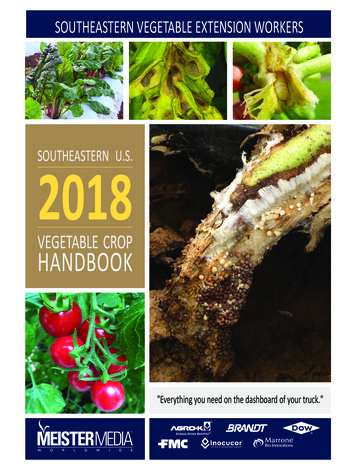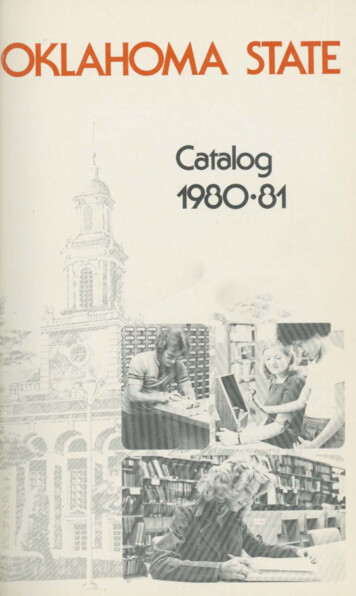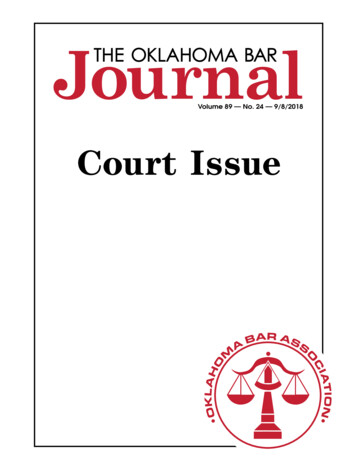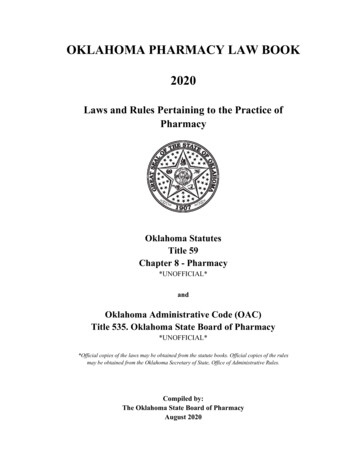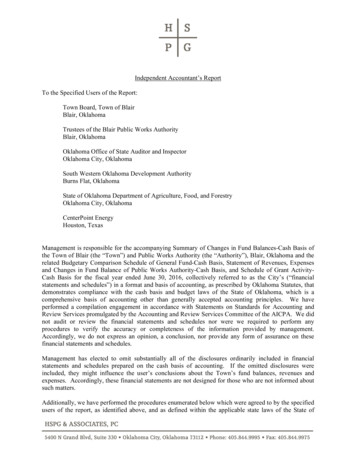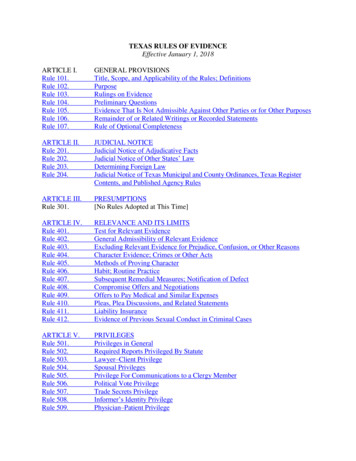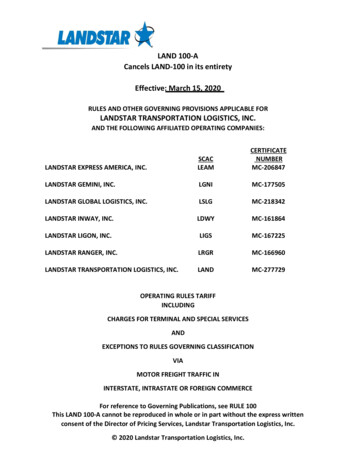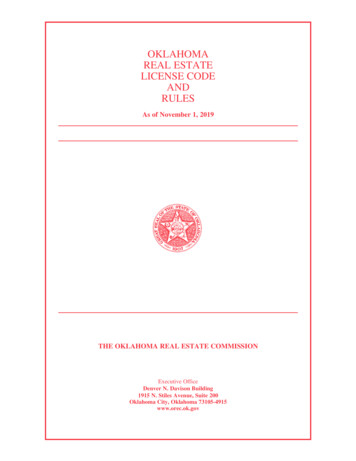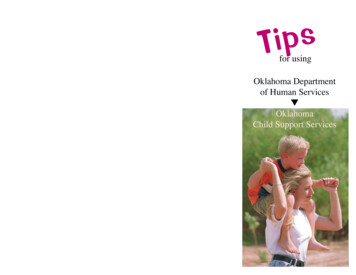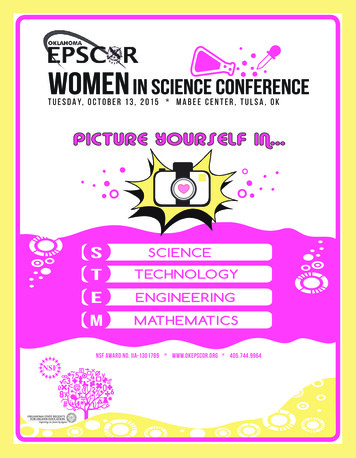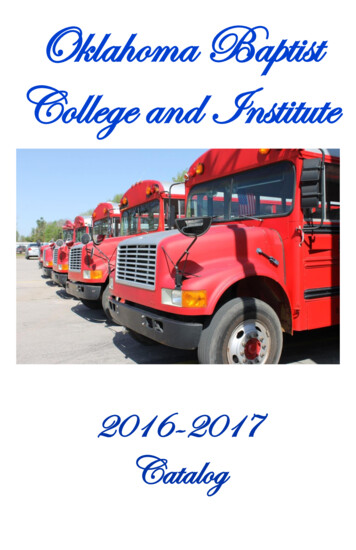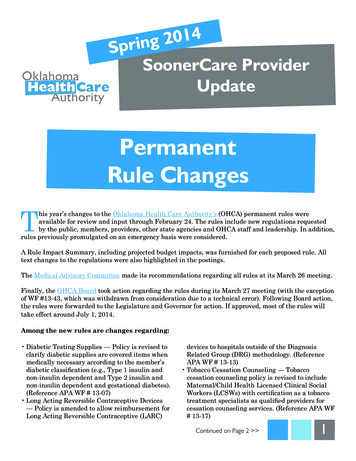
Transcription
4102gnSpriSoonerCare ProviderUpdatePermanentRule ChangesThis year’s changes to the Oklahoma Health Care Authority’s (OHCA) permanent rules wereavailable for review and input through February 24. The rules include new regulations requestedby the public, members, providers, other state agencies and OHCA staff and leadership. In addition,rules previously promulgated on an emergency basis were considered.A Rule Impact Summary, including projected budget impacts, was furnished for each proposed rule. Alltext changes to the regulations were also highlighted in the postings.The Medical Advisory Committee made its recommendations regarding all rules at its March 26 meeting.Finally, the OHCA Board took action regarding the rules during its March 27 meeting (with the exceptionof WF #13-43, which was withdrawn from consideration due to a technical error). Following Board action,the rules were forwarded to the Legislature and Governor for action. If approved, most of the rules willtake effect around July 1, 2014.Among the new rules are changes regarding: Diabetic Testing Supplies — Policy is revised toclarify diabetic supplies are covered items whenmedically necessary according to the member’sdiabetic classification (e.g., Type 1 insulin andnon-insulin dependent and Type 2 insulin andnon-insulin dependent and gestational diabetes).(Reference APA WF # 13-07) Long Acting Reversible Contraceptive Devices— Policy is amended to allow reimbursement forLong Acting Reversible Contraceptive (LARC)devices to hospitals outside of the DiagnosisRelated Group (DRG) methodology. (ReferenceAPA WF # 13-13) Tobacco Cessation Counseling — Tobaccocessation counseling policy is revised to includeMaternal/Child Health Licensed Clinical SocialWorkers (LCSWs) with certification as a tobaccotreatment specialists as qualified providers forcessation counseling services. (Reference APA WF# 13-17)Continued on Page 2 1
Genetic Testing — Policy is being revised toadd language that sets boundaries as to whatare deemed approved genetic testing methods.Problems have recently arisen which call for morestringent policy, particularly issues regarding labbilling for expensive methods that lack sufficientevidence for their use. (Reference APA WF # 13-26) Fluoride Varnish — Policy is revised to expandthe age for which application of fluoride varnishduring course of a well-child screening is covered,from ages 12 months to 42 months to ages 6months to 60 months. (Reference APA WF # 1351)Click here to view the complete list.OHCA Adds New Measure to Combat PublicCrisis of Prescription Drug AbuseThe mission of the OHCA Lock-In Program is to assist health care providers in monitoring potential abuseor inappropriate utilization of controlled prescription medications by SoonerCare members.The OHCA has a new weapon in the war against prescription drug abuse.The agency has ramped-up its Pharmacy Lock-in Program so that certainSoonerCare members cannot receive controlled substances from morethan one prescriber. The measure aims to deter the practice of doctor shoppingand prevent the possibility of accidental drug overdose – a growing and deadlyproblem in Oklahoma. The new lock-in requirement begins in summer 2014.“We simply feel this is a necessary change to create a more effective and relevantlock-in program,” said OHCA’s Health Care Management Medical Director,Dr. Mike Herndon. “We believe this additional measure will have a significantimpact on the number of prescriptions those members who are in the Lock-inProgram are able to acquire.”Presently, those SoonerCare members who are at risk of misusing prescribedcontrolled substances are restricted to the use of one pharmacy to fill all oftheir medications. The new requirement will limit these members to using both a single pharmacy andprescriber. Pharmacy claims will be blocked from a prescriber who is not the lock-in member’s authorizedprescriber. However, this lock-in will only apply to controlled substance prescriptions.Prescription drug abuse is an epidemic in Oklahoma, narcotics in particular. According to a recent reportby the Trust for America’s Health, the Sooner state has the fifth highest drug overdose mortality rate inthe U.S., a rate that tripled from 1999 to 2010.2
New 1500 FormAs of April 1, 2014, the new 1500 Professional claim form is mandatory. When submitting the newform, be sure to use the following new format:#1- Box 10D: This field will no longer be used. Report any Third Party Liability (TPL) payments in box29 or Carrier Denied in box 19#2- Box 17: This field will now require qualifier “DN” for referring provider or qualifier “DK” for ordering provider#3- Box 19: This field will now be used to report “Carrier Denied” on a claim#4- Box 21: This field has expanded to allow a maximum of 12 diagnosis codes with seven characters per code.#5- Box 29: This field will now be used to report TPL payments#6- Box 30: This field will no longer be used. Leave this box blank.For additional information visit our New 1500/Professional Claim Form Instructions.3
Stage 2 Begins for the OklahomaEHR Incentive ProgramFor 2014 only, regardless of your stage of meaningful use, you will only demonstrate meaningful usefor a three-month Electronic Health Records (EHR) reporting period. Stage 2 retains the core and menu structure for meaningful use objectives. While some objectivesfrom Stage 1 were either combined or eliminated, most of the Stage 1 objectives are now coreobjectives in Stage 2. Stage 2 also replaces the previous Stage 1 objective to provide electronic copies of health informationor discharge instructions and provide timely access to health information with objectives that allowpatients access their health information online. Stage 1 measures that were kept have higher thresholds for Stage 2.Eligible Professional (EP) EPs must meet 17 core objectives and threemenu objectives that you select from a list ofsix, or a total of 20 core objectives. EPs have a new core measure in whichthey will use secure electronic messaging tocommunicate with patients on relevant healthinformation. EPs will need to provide patients the abilityto view online, download and transmit theirhealth information within four business daysof the information being available to the EP.Eligible Hospital (EH) EHs must meet 16 core objectives and threemenu objectives that you select from a list ofsix, or a total of 19 core objectives. EHs have a new core measure in which theywill need to automatically track medicationsfrom order to administration using assistivetechnologies in conjunction with an electronicmedication administration record (eMAR). EHs will need to provide patients the abilityto view online, download and transmit theirhealth information within 36 hours afterdischarge from the hospital.Stage 2 criteria place an emphasis on health information exchange between providers to improve carecoordination for patients. One of the core objectives for both EPs and EHs requires providers whotransition or refer a patient to another setting of care or provider of care to submit a summary of carerecord for more than 50 percent of those transitions of care and referrals. For more than 10 percent of transitions and referrals, EPs and EHs who transition or refer theirpatient to another setting of care or provider of care must provide a summary of care recordelectronically. EPs or EHs who transitions or refers their patient to another setting of care or provider of care musteither a) conduct one or more successful electronic exchanges of a summary of care record with arecipient using technology that was designed by a different EHR developer than the sender’s, or b)conduct one or more successful tests with the CMS designated test EHR during the EHR reportingperiod.Starting in 2014, all providers are required to submit supporting patient volume documentation. Thisdocumentation may be faxed to 405-601-9797 or emailed to EHRDocuments@okhca.org. Remember, PHImust be sent via secure email. Please include the tracking number provided on the fax cover sheet andprovider’s name in the subject line. The patient volume report is required to consist of the following:4 Provider name SoonerCare provider ID Member/Patient name SoonerCare member ID Date of service Primary diagnosisContinued on Page 5
All other supporting documents may only be submitted via fax to 405-601-9797.This documentation consists of the following: Fax coversheet provided (contains tracking number) Vendor letter or entire signed and dated contract Signed contract amendment If attesting to 20-29 percent for board certified pediatricians, proof of boardcertificationCMS Medicare and Medicaid Meaningful use reportEHR Incentive Programs Any OHCA requested supporting reports ordocumentationMedicare paymentThe EHRDocuments@okhca.org email addressis strictly for patient volume reports only. Anyother documents sent to this email address willnot be processed and the attestation will not beapproved until other supporting documents havebeen successfully received via fax.For further information, please contact theOklahoma EHR Program Education Team atOKEHRIncentive@okhca.org or 405-522-7EHR.adjustmentsbegin for EPsand EHs that arenot meaningfulusers of EHRtechnology2014Last yearto initiateparticipation inthe MedicareEHR IncentiveProgram2015Last year to receiveMedicaid EHRIncentive payment20162021Last year to receivea Medicare EHRIncentive PaymentLast year to initiateparticipation inMediacid EHRIncentive ProgramConnecting DME toOklahomans in NeedThe Oklahoma Durable Medical Equipment Reuse Program(OKDMERP), a partnership between the OHCA andOklahoma ABLE Tech, offers Oklahomans the opportunityto donate gently used DME to other Oklahoma residents in need.While SoonerCare and SoonerCare beneficiaries have priority, allOklahoma residents with disabilities and/or health conditions areeligible to participate in the program regardless of age, income orinsurance coverage. Participation is at no cost to the recipient.OKDMERP inventory includes a range of devices to meet a variety ofneeds. DME that may be donated or includes: CPAPs, gait trainers,nebulizers, quad canes, shower chairs, walkers, bath benches,commodes, patient lifts, standers, hospital beds, wheelchairs andscooters. All Oklahoma Mobility Plus locations accept donations onbehalf of OKDMERP, and donations are tax-deductible.If you are interested in donating an item or you know a patient in need of equipment, please contactOKDMERP at 405-523-4810 or by email at katie.woodward@okstate.edu.5
Think Teeth:Help Create Smiles for ChildrenThe Centers for Medicare & Medicaid Services (CMS) is deeply involved in promoting preventivedental services for patients eligible for benefits under Medicaid, Children’s Health InsuranceProgram (CHIP) and the Health Insurance Marketplaces. CMS announced the Oral HealthInitiative in 2010 to promote these services in Medicaid and CHIP. Under the initiative, state Medicaidand CHIP programs are encouraged to increase the number of children receiving dental sealants as wellas prophylaxes and topical fluoride treatments.CMS is working with states to increase by FFY 2015 the number of children (ages 1-20) receiving apreventive dental service by 10 percentage points over an established state baseline. For Oklahoma, thatbaseline is 44%.Fluoride has been recognized as vitally important for caries prevention for almost 70 years. Communitywater fluoridation is the cornerstone of caries prevention and according to the Centers for Disease Controland Prevention (CDC) almost 70 percent of Americans on community water systems enjoy the benefits ofwater fluoridation. Topical fluoride treatments have also been proven effective for many years. We havebeen through painting stannous fluoride on teeth with a cotton swab, having patients hold fluoride gelsand foams in their mouths for minutes and even giventhem prescription-level fluorides for home use.Arguably the most effective topical fluoride treatmentnow available is in the form of fluoride varnish.Available from many different vendors, fluoride varnishis applied relatively quickly and easily. Under statepractice acts, rules and regulations, a wide variety ofhealth care professionals can provide fluoride varnish toeven our youngest patients. Our medical colleagues arealso encouraged to provide fluoride varnish because theyoften see children at a younger age than many receivingdental care – even though the recommendation is thatchildren have their first dental visit by age one or at theeruption of the first teeth.The science of dental sealants has been established for many years. The efficacy of sealant placement onpermanent molars is well-researched. School-based dental sealant programs are even recommended bythe Community Preventive Services Task Force.Newly designed “Think Teeth” awareness materials can help your patients understand the importance ofprevention. They are available for free on the Insure Kids Now website.To view the OHCA’s recommendations for pediatric oral health care, visit our website.*This CMS message from Lynn Douglas Mouden, DDS, MPH, FICD, FACD, isforwarded to Oklahoma’s dentists on behalf of the OHCA.6Dr. Mouden, with almost 40 years of background in private practice and dentalpublic health, now serves as Chief Dental Officer for the CMS.
A Word About SoonerCareFluoride VarnishBy Leon Bragg,DDS, MEdOHCA Chief Dental OfficerSoonerCare medical providers can receive training and certification influoride varnish through the Smile for Life Oral Health Curriculum. Twoweb-based courses are required for physicians (and their trained staff) tobe eligible for reimbursement.Currently, nearly 70 individual SoonerCare PCPs are certified and eligiblefor reimbursement through this program. Visit online for more details aboutSoonerCare Fluoride Varnish.Demystifying Maternity BenefitsPregnancy services are offered to qualified Oklahoma women to increase the likelihood of a healthypregnancy and birth. However, some women are eligible for the full-scope of SoonerCare benefits,whereas others qualify for a more limited range of services through Soon-To-Be-Sooners (STBS).The following pregnancy related services are the same for women whose benefit program is SoonerCare orSTBS. These services include: Routine office visits for prenatal care; Pregnancy-related medication; Two ultrasounds (one in the first trimester; one in the second or third trimester) and lab servicesrelated to the pregnancy; Limited medically necessary specialty and high risk obstetrical care with prior authorization; and Delivery services.STBS pregnancy services are limited to those listed above.However, a pregnant woman with full-scope SoonerCare has additional benefits, including non-emergencytransportation (SoonerRide), emergency department services, limited dental coverage and post-partumcare. These members may also receive services for other conditions in accordance with SoonerCareprogram benefits and exclusion policies for children and adults.A side-by-side comparison of SoonerCare and STBS obstetrical coverage can be found on our website.OHCA will soon be issuing an Obstetrical Care Providers Educational Materials Provider Letter, withcomplete updates for 2014. These comprehensive materials will include a comparison chart of benefitsalong with a Quick Reference Guide related to obtaining necessary authorizations.OHCA policy regarding benefits for pregnant women can be referenced at www.okhca.org under Provider,Policy & Rules, OHCA Rules, Chapter 30, 317:30-5-22.Providers with maternity benefits or policy questions may contact SoonerCareProvider Services at 800-522-0114, option 1.7
Tech Use May Influence Health,Happiness of FamiliesBy: Sylvia Lopez,MD, FAAP andOHCA Chief Medical OfficerNew research further suggests that when caregivers put the brakes ontheir mobile device use they may help fast-track a child’s developmentand build stronger family bonds.The object of the study published in the journal Pediatrics was to observe adultcaregivers and children eating out in restaurants to determine how the useof digital devices (i.e. smartphones and tablets) during mealtimes may affectparent-child interaction.Researchers witnessed that most adults used some kind of mobile deviceduring or at the end their meals. Of the 55 groups in the study, only 15 wereobserved to use no mobile device. Furthermore, it was those adults who were more engaged with thechildren in their care.In contrast, children observed in the groups engaged in the use of hand-held devices exhibited behaviorsthat ranged from acceptance to limit-testing - many of the latter of whom attempted to garner attentionfrom the caregivers. These provocative behaviors were met with inattention, insensitivity to the child’sneeds or a physical response. Those caregivers who were highly absorbed in their devices were alsoobserved to respond most harshly.The American Academy of Pediatrics periodically issues policy statements on the use of media in thefamily setting and the limitations we should set. Social media is ubiquitous and cannot be reasonablyavoided, but parents should set boundaries for the sake of their children.An especially important time for families is dinnertime. This should be a time for families to come togetherand share experiences while eating a nutritious meal. In many cases, this is the only time that the entirefamily is together.What pediatricians like to stress is that the interaction between a parent and his/her child and theinteractions among the children in the family are important in establishing family values and promotingcharacter and responsibility. It is also important in the development of good vocabulary. Dinnertime isoften the only time that parents directly hear from their children what has transpired at school. It isan opportunity for parents to hear from the children what matters to them. The best way to have thisdialogue is to put the cell phones and other mobile devices away for 30 minutes.When our children were young, we set the ground rules early. The entire family had dinner togetherevery day. During dinner, there were no distractions. No one answered the phone when it rang. We didn’tturn on the TV. No cell phones were allowed in the dining room. Everyone understood that it was thefamily’s time for conversation and eating and it was important. To this day, our children tell us that theywere glad we insisted on having it this way because this time created memories for them.8There are so many distractions for our children today. The family needs to setaside some time every day for one-on-one dialogue with all the members of thefamily and make it a priority.
Spring ProviderTraining WorkshopTulsa – April 30 and May 1Oklahoma City – May 14 and 15All courses will be available at each location each day.Registration is available online.Recover Audit ProgramMedication PA & Billing for PhysiciansDescription:This presentation is an overview of the OklahomaRecover Audit Program - a new program that is inthe final stages of implementation. The purposeof the program is to identify overpayments andunderpayments.View the presentation online.Durable Medical EquipmentDescription:The Durable Medical Equipment (DME) classcovers rule changes including diabetic supplies,manual pricing process and oxygen. It covers theimpact that competitive bidding has on the OHCA,as well as budget issues.View the presentation online.Electronic Health RecordsDescription:This course is designed to assist all eligibleproviders who plan on participating in theOklahoma EHR Incentive Program. An eligibleprovider is an M.D., D.O., ARNP, Certified Midwife,Pediatrician, Dentist, P.A. (only if practicing ata FQHC/RHC led by a P.A.), acute care hospital(including cancer and critical access), and children’shospitals. The most recent information is providedas well as some handy tips learnedfrom earlier provider attestations. We also showyou the steps necessary to attest for the OklahomaEHR Incentive Program.View the presentation online.Description:This class provides information about medicationprior authorizations for both pharmacy andphysician administered drugs. The class alsocovers information for billing J codes with NDC onclaims.View the presentation online.Provider Portal PlaybookDescription:The Provider Portal Playbook is set to give youa wealth of “game day” knowledge by coveringvarious topics on the new Provider Portal. Get tips,tricks and shortcuts related to the portal. Topicsof discussion include: accessing the site, managingaccounts, researching claims and many otherfunctions.View the presentation online.Adjustments-Third Party LiabilityDescription:This class explains when and why adjustmentsare required, as well as instructions on requestingan adjustment for all claim types. The class alsocovers Third Party Liability (TPL) topics includingHMO copayments and Medicare replacements andsupplements. The forms covered for this class are:HCA-14, HCA-15, HCA-28, Pharm3, and TPL1.View the presentation online.Continued on Page 10 9
Special Process ClaimsDescription:This class addresses when, why and how to senda claim for special processing/manual review. Itcovers 1500 Professional and UB-04 Institutionalclaim examples, including timely filing, the HCA17 and HCA-28 forms, Return to Provider letter,and claims that do not need to be sent for specialprocessing.View the presentation online.Tobacco CessationDescription:This class has three objectives related to tobaccocessation: 1) to educate providers on tobaccocessation best practices, specifically the 5A’scounseling methodology, 2) to teach providers aboutSoonerCare’s tobacco cessation benefits and how tobill and document appropriately, and 3) tofamiliarize providers with the Oklahoma TobaccoHelpline as a free resource for their patients.View the presentation online.Oklahoma is National Model in theGrowing Field of GeneticsOklahoma’s work in the field of genetics has been leading the way for Medicaid agencies. The OHCAis unique among other states in that it’s the only state agency in the country to have a geneticiston-staff. Dr. Alison Adams Martinez, Ph.D., recently presented on Oklahoma’s approach andpolicies towards genetic testing for the National Association of Medicaid Directors (NAMD).“Oklahoma is always looking to share our perspective on genetic testing and promote a nationwide freeexchange of ideas on this topic,” said Martinez.The use of genetic testing and other molecular pathology (MolPath) services are on the rise, withapplications ranging from diagnostics to personalized medicine. While these technologies promise excitingnew improvements in patient care, most tests do not require the Federal Drug Administration’s approval,and their impact on outcomes may not be supported by solid evidence. If not monitored, novel technologiescould lead to costly and potentially wasteful spending by Medicaid agencies.“Part of our role at the Oklahoma Health Care Authority is to make sure that our members have access tothe most clinically beneficial technologies, and we are trying to be thorough and thoughtful in evaluatingthe benefits and drawbacks of new genetic tests,” said Martinez.Dr. Martinez joined the Medical Professional Services unit of the OHCA in 2012. In her role as geneticist,Martinez reviews and develops recommendations for coverage of genetic testing and responds to inquiriesfrom SoonerCare providers regarding these new technologies.Visit online for more information on the role of genetics at OHCA.Correction10The OHCA would like to correct information that was given in the last ProviderUpdate. The second item in the “Update on Durable Medical EquipmentChanges” should read, “Allow one rental period per calendar month for K0001for 13 months total within a 60-month period.”
New FDA Safety Guidelines for Prescribingand Dispensing AcetaminophenThe Federal Drug Administration (FDA) is recommending health care professionals discontinueprescribing and dispensing prescription combination drug products that contain more than 325milligrams (mg) of acetaminophen (APAP) per tablet, capsule or other dosage unit. There are noavailable data to show that taking more than 325 mg of APAP per dosage unit provides additional benefitthat outweighs the added risks for liver injury. Further, limiting the amount of APAP per dosage unitwill reduce the risk of severe liver injury from inadvertent APAP overdose, which can lead to liver failure,liver transplant and death.It is recommended that health care professionals: Counsel patients not to exceed the APAP maximum total daily dose (fourgrams/day) Educate patients about the importance of reading all prescription andover-the-counter (OTC) labels to ensure they are not taking multipleAPAP-containing products Advise patients not to drink alcohol while taking APAP-containingmedications Instruct patients to seek immediate medical assistance if they have takenmore APAP than directed or experience swelling of the face, mouth andthroat, difficulty breathing, itching and rashAccidental overdose from prescription combination drugs containing APAPaccounts for nearly half of all cases of APAP-related liver failure in the UnitedStates. When making individual dosing determinations, health care providersshould always consider the amount of both APAP and the opioid components inthe prescription combination drug product.SoonerCare hasinitiated ingredientduplication editswhen multiple claimsfor APAP-containingmedications areattempted for itsmembers withina designatedtimeframe.An ingredientduplication reviewis now requiredwhen the APAPduplication occurs.This FDA safety alert was issued on Jan. 14. OTC APAP products will be addressed in another regulatoryaction.Health care providers and pharmacists who have further questions are encouraged to contact the Divisionof Drug Information at 888.INFO.FDA (888-463-6332) or druginfo@fda.hhs.gov.To report adverse events or side effects related to the use of these products to theFDA’s MedWatch Safety Information and Adverse Event Reporting Program: Complete and submit the report online or call 800-332-1088 to request a reporting form, thencomplete and return to the address on the pre-addressed form, or submit by fax to 800-FDA-0178.Don’t forget!You can stay abreast of the latest OHCA policy changes and other importantinformation by visiting the Provider section of our website. Provider Letters Global Messages11
OHCA Has MovedThe OHCA would like to notify our providers, membersand the general public of our relocation to LincolnCenter, just north of the state capitol. Our new address is4345 N. Lincoln, Oklahoma City, OK 73105. All other contactinformation (i.e. phone and numbers) remains the same.To find us, take the Lincoln Boulevard exit off I-44 and headsouth; we are located on the west side of the street. Our corebusiness hours are from 8 a.m. – 5 p.m. Monday - Friday, andvisitors’ parking is at the front (east side) of the building.Provider Update is published by the Oklahoma Health Care Authority (www.okhca.org) for Oklahoma’sSoonerCare providers. This publication is issued by the Oklahoma Health Care Authority in conjunctionwith Jones Public Relations, Inc., as authorized by 63 O.S. Supp. 1997, Section 5013. Distribution of theOHCA SoonerCare Provider Update was 9,651.56.The Oklahoma Health Care Authority does not discriminate on the basis of race, color, national origin,sex, religion, age or disability in employment or the provision of services.Please submit any questions, comments or story suggestions to Kelli Brodersen (kelli.brodersen@okhca.org) atthe Oklahoma Health Care Authority’s Public Information Office at 405-522-7504.Oklahoma Health Care Authority4345 N. Lincoln, Oklahoma City, OK 73105OHCA Provider Helpline: 800-522-0114Chief Executive OfficerNico GomezMedicaid DirectorGarth L. Splinter, MD, MBAManaging EditorKelli BrodersenPublic Information SpecialistOHCA Board of DirectorsEd McFall, ChairmanPorumAnthony Armstrong, Vice ChairmanMuskogeeGeorge A. MillerBethanyCarol RobisonOologahMelvin R. McVay Jr.Be sure to follow us on social media:Oklahoma CityMarc NuttleNormanAnn BryantEnid12
recipient using technology that was designed by a different EHR developer than the sender's, or b) . CMS is working with states to increase by FFY 2015 the number of children (ages 1-20) receiving a . Available from many different vendors, fluoride varnish is applied relatively quickly and easily. Under state . practice acts, rules and .

